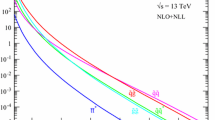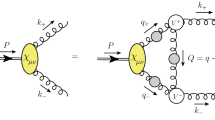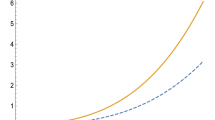Abstract.
We study the potential of high-energy photon colliders for the production of gluino pairs within the minimal supersymmetric standard model (MSSM). In this model, the process \(\gamma\gamma\to\tilde{g}\tilde{g}\) is mediated by quark/squark box diagrams with enhancements for up-type quarks/squarks from their larger charges and for third generation squarks from their large mass splittings, generated by the mixing of left- and right-handed states. Far above threshold and in scenarios with very heavy squarks, resolved photons can contribute significantly at tree level. Taking into account the laser photon backscattering spectrum, electron and laser beam polarization effects, and current mass exclusion limits, we find that gluino pair production in high-energy photon collisions should be visible over large regions of the MSSM parameter space, contrary to what has been found for e + e - annihilation. In addition, the cross section rises rather steeply, so that a gluino mass determination with a precision of a few GeV should be feasible for a wide range of post-LEP benchmark points.
Similar content being viewed by others
References
H.P. Nilles, Phys. Rept. 110, 1 (1984)
H.E. Haber, G.L. Kane, Phys. Rept. 117, 75 (1985)
M. Carena et al. [Higgs Working Group Collaboration], hep-ph/0010338
S. Abel et al. [SUGRA Working Group Collaboration], hep-ph/0003154
R. Culbertson et al. [Gauge Mediation Working Group Collaboration], hep-ph/0008070
S. Ambrosanio et al. [BMSSM Working Group Collaboration], hep-ph/0006162
B. Allanach et al. [RPV Working Group Collaboration], hep-ph/9906224
A. Airapetian et al. [ATLAS Collaboration], CERN-LHCC-99-15
S. Abdullin et al. [CMS Collaboration], J. Phys. G 28, 469 (2002)
J.A. Aguilar-Saavedra et al. [ECFA/DESY LC Physics Working Group Collaboration], hep-ph/0106315
S. Berge, M. Klasen, Phys. Rev. D 66, 115014 (2002)
S. Berge, M. Klasen, contribution to SUSY 02, hep-ph/0210420
G. Jikia, S. Söldner-Rembold, Nucl. Phys. Proc. Suppl. 82, 373 (2000)
M. Melles, W.J. Stirling, V.A. Khoze, Phys. Rev. D 61, 054015 (2000)
P. Niezurawski, A.F. Zarnecki, M. Krawczyk, Acta Phys. Polon. B 34, 177 (2003)
M.M. Mühlleitner, M. Krämer, M. Spira, P.M. Zerwas, Phys. Lett. B 508, 311 (2001)
S. Chakrabarti, D. Choudhury, R.M. Godbole, B. Mukhopadhyaya, Phys. Lett. B 434, 347 (1998)
S. Berge, M. Klasen, Y. Umeda, Phys. Rev. D 63, 035003 (2001)
M. Klasen, Nucl. Instrum. Meth. A 472, 160 (2001)
B. Badelek et al. [ECFA/DESY Photon Collider Working Group Collaboration], hep-ex/0108012
I.F. Ginzburg, G.L. Kotkin, S.L. Panfil, V.G. Serbo, V.I. Telnov, Nucl. Instrum. Meth. A 219, 5 (1984)
K. Hagiwara et al. [Particle Data Group Collaboration], Phys. Rev. D 66, 010001 (2002)
T. Affolder et al. [CDF Collaboration], Phys. Rev. Lett. 88, 041801 (2002)
S. Abachi et al. [D0 Collaboration], Phys. Rev. Lett. 75, 618 (1995)
M. Felcini, C. Tully et al. [LEP Higgs Working Group Collaboration], Note 2001-04, hep-ex/0107030
T. Hahn, C. Schappacher, Comput. Phys. Commun. 143, 54 (2002)
J. Abdallah et al. [LEP SUSY Working Group Collaboration], http://lepsusy.web.cern.ch/lepsusy
J. Küblbeck, M. Böhm, A. Denner, Comput. Phys. Commun. 60, 165 (1990)
T. Hahn, Comput. Phys. Commun. 140, 418 (2001)
G.J. van Oldenborgh, J.A. Vermaseren, Z. Phys. C 46, 425 (1990)
G.J. van Oldenborgh, Comput. Phys. Commun. 66, 1 (1991)
T. Hahn, M. Perez-Victoria, Comput. Phys. Commun. 118, 153 (1999)
S.P. Li, H.C. Liu, D. Silverman, Phys. Rev. D 31, 1736 (1985)
S. Dawson, E. Eichten, C. Quigg, Phys. Rev. D 31, 1581 (1985)
M. Glück, E. Reya, A. Vogt, Phys. Rev. D 46, 1973 (1992)
H. Burkhardt, V. Telnov, CERN-SL-2002-013-AP
M. Battaglia et al., Eur. Phys. J. C 22, 535 (2001)
G.A. Schuler, T. Sjostrand, Z. Phys. C 68, 607 (1995)
M. Klasen, Rev. Mod. Phys. 74, 1221 (2002)
Author information
Authors and Affiliations
Corresponding author
Additional information
Received: 5 March 2002, Published online: 8 July 2003
Rights and permissions
About this article
Cite this article
Berge, S., Klasen, M. Gluino pair production in high-energy photon collisions. Eur. Phys. J. C 30, 123–133 (2003). https://doi.org/10.1140/epjc/s2003-01194-4
Issue Date:
DOI: https://doi.org/10.1140/epjc/s2003-01194-4




